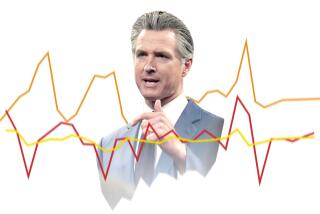We, The Taxpayers
California’s arcane system of state and local taxes hits every household differently. To gauge the bite, The Times asked a cross-section of Southern California residents to pull out their tax returns and talk about the system. To make it easier to compare these tax bills to your own, the stories are color-coded with the charts shown here, which provide several measures of tax bite and after-tax wealth.
Income Groups Defined: Using Franchise Tax Board data for 1970, 1980 and 1990, The Times divided tax-paying households by income into five groups of equal size. In 1990, the groups were defined this way:
FLING AND ANNETTE TRAYLOR: Upper (Top 20% of earners) $50,001 and Over
AGES: 61 and 58
WHERE: Whittier
JOBS: Business owner, homemaker
1992 INCOME: $305,693
1992 STATE AND LOCAL TAXES: $56,946
VIEWPOINT: “I look at government the same as they look at us--’They versus us.’ “--Fling Traylor
Asked whether he thinks of himself as rich, middle class or poor, Fling Traylor says matter-of-factly, “not the latter two.”
In 1990, his income reached $495,000 from investments and ownership of a business in the City of Industry that employs up to 22 workers making rubber floor tiles and industrial products.
Though the firm has felt the state’s recession--reducing Traylor’s income by nearly $100,000 each of the last two years--he has created a good life for his wife and three children, including a vacation home in Ventura and a ranch in San Luis Obispo.
It was the purchase of the latter property in 1982 that spurred Traylor’s interest in the state and local tax systems--an interest that has grown into a passionate hobby. He keeps a copy of a 1935 declaration by the U.S. Supreme Court: “The legal right of a taxpayer to decrease the amount of what otherwise would be his taxes, or all together avoid them, by means which the law permits cannot be doubted.”
Before he bought the ranch, “I didn’t care about anything but keeping my company going,” Traylor recalls. But then he got the assessor’s notice and found that the land he bought for $80,000 had been valued at $134,000. He researched the matter, appealed, and got the assessment reduced to $105,000.
“I decided that things weren’t right in the taxing system,” he says.
Several years later, his properties in Ventura and Whittier became subject to “special assessment districts”--an increasingly popular way to raise funds in post-Proposition 13 California. In Whittier, the local high school district began imposing $20 fees on homeowners. The rationale: The public often used certain school facilities--such as playing fields and auditoriums--so it should help pay the upkeep.
“That was the final blow,” says Traylor, who viewed the new levy as “a subterfuge . . . a sneaky tax” employed by school officials who could not live within their budgets. He spoke out at a public hearing, then allowed his name to be used as a plaintiff in a lawsuit filed by the Howard Jarvis Taxpayers Assn. challenging the assessment.
“It was the principle,” Traylor says of the unsuccessful lawsuit--not “the dollars.”
In fact, Fling hardly can be called a raving anti-taxer. He worries more about the middle class than the wealthy because “the average income worker, they allow themselves to be taken advantage of. I think they’re overtaxed.”
And he neither complains about state taxes on business nor favors tax incentives to keep business in California: “I believe in free enterprise--as long as it’s not hindered. . . . I believe free enterprise will grow on it’s own . . . it doesn’t need true incentives.”
If taxes need to be increased, he would like to see something “leveled on the basis of usage, . . . an across-the-board type tax.”
As for the ranch that first got him on the tax kick? The assessor may soon be back; Traylor is putting in a vineyard.
WHAT THEY PAID
State Income Tax: $30,946
Property Tax: $22,000
Estimated Sales Tax: $3,861
State and Local Taxes as a Percentage of Income: 18.6%
*
Data analysis by Richard O’Reilly, Times directoy of computer analysis, and Times researcher Nona Yates from Franchise Tax Board, California Department of Finance and State Board of Equalization data.
More to Read
Inside the business of entertainment
The Wide Shot brings you news, analysis and insights on everything from streaming wars to production — and what it all means for the future.
You may occasionally receive promotional content from the Los Angeles Times.










